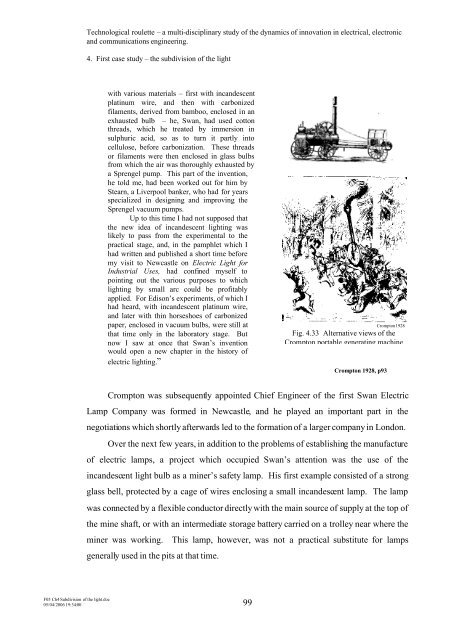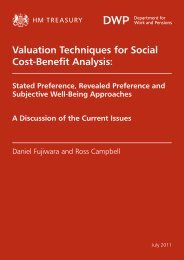4. First case study – the subdivision of the light - HM Treasury
4. First case study – the subdivision of the light - HM Treasury
4. First case study – the subdivision of the light - HM Treasury
You also want an ePaper? Increase the reach of your titles
YUMPU automatically turns print PDFs into web optimized ePapers that Google loves.
F05 Ch4 Subdivision <strong>of</strong> <strong>the</strong> <strong>light</strong>.doc<br />
05/04/2006 19:34:00<br />
Technological roulette <strong>–</strong> a multi-disciplinary <strong>study</strong> <strong>of</strong> <strong>the</strong> dynamics <strong>of</strong> innovation in electrical, electronic<br />
and communications engineering.<br />
<strong>4.</strong> <strong>First</strong> <strong>case</strong> <strong>study</strong> <strong>–</strong> <strong>the</strong> <strong>subdivision</strong> <strong>of</strong> <strong>the</strong> <strong>light</strong><br />
with various materials <strong>–</strong> first with incandescent<br />
platinum wire, and <strong>the</strong>n with carbonized<br />
filaments, derived from bamboo, enclosed in an<br />
exhausted bulb <strong>–</strong> he, Swan, had used cotton<br />
threads, which he treated by immersion in<br />
sulphuric acid, so as to turn it partly into<br />
cellulose, before carbonization. These threads<br />
or filaments were <strong>the</strong>n enclosed in glass bulbs<br />
from which <strong>the</strong> air was thoroughly exhausted by<br />
a Sprengel pump. This part <strong>of</strong> <strong>the</strong> invention,<br />
he told me, had been worked out for him by<br />
Stearn, a Liverpool banker, who had for years<br />
specialized in designing and improving <strong>the</strong><br />
Sprengel vacuum pumps.<br />
Up to this time I had not supposed that<br />
<strong>the</strong> new idea <strong>of</strong> incandescent <strong>light</strong>ing was<br />
likely to pass from <strong>the</strong> experimental to <strong>the</strong><br />
practical stage, and, in <strong>the</strong> pamphlet which I<br />
had written and published a short time before<br />
my visit to Newcastle on Electric Light for<br />
Industrial Uses, had confined myself to<br />
pointing out <strong>the</strong> various purposes to which<br />
<strong>light</strong>ing by small arc could be pr<strong>of</strong>itably<br />
applied. For Edison’s experiments, <strong>of</strong> which I<br />
had heard, with incandescent platinum wire,<br />
and later with thin horseshoes <strong>of</strong> carbonized<br />
paper, enclosed in vacuum bulbs, were still at<br />
that time only in <strong>the</strong> laboratory stage. But<br />
now I saw at once that Swan’s invention<br />
would open a new chapter in <strong>the</strong> history <strong>of</strong><br />
electric <strong>light</strong>ing.”<br />
99<br />
Crompton 1928, p93<br />
Crompton was subsequently appointed Chief Engineer <strong>of</strong> <strong>the</strong> first Swan Electric<br />
Lamp Company was formed in Newcastle, and he played an important part in <strong>the</strong><br />
negotiations which shortly afterwards led to <strong>the</strong> formation <strong>of</strong> a larger company in London.<br />
Over <strong>the</strong> next few years, in addition to <strong>the</strong> problems <strong>of</strong> establishing <strong>the</strong> manufacture<br />
<strong>of</strong> electric lamps, a project which occupied Swan’s attention was <strong>the</strong> use <strong>of</strong> <strong>the</strong><br />
incandescent <strong>light</strong> bulb as a miner’s safety lamp. His first example consisted <strong>of</strong> a strong<br />
glass bell, protected by a cage <strong>of</strong> wires enclosing a small incandescent lamp. The lamp<br />
was connected by a flexible conductor directly with <strong>the</strong> main source <strong>of</strong> supply at <strong>the</strong> top <strong>of</strong><br />
<strong>the</strong> mine shaft, or with an intermediate storage battery carried on a trolley near where <strong>the</strong><br />
miner was working. This lamp, however, was not a practical substitute for lamps<br />
generally used in <strong>the</strong> pits at that time.<br />
Crompton1928<br />
Fig. <strong>4.</strong>33 Alternative views <strong>of</strong> <strong>the</strong><br />
Crompton portable generating machine





![AIRTO [Professor Dr Brian Blunden] - HM Treasury](https://img.yumpu.com/15492848/1/184x260/airto-professor-dr-brian-blunden-hm-treasury.jpg?quality=85)










